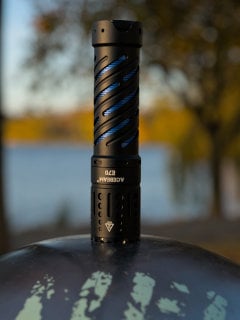

One hour of runtime is more than enough for a single mode keychain light IMHO. Don’t think skilhunt will expand in that direction.
Software developer from Germany with interests in programming, electronics, flashlights, calculators, writing instruments and various outdoor activities.
Visit my website for more info and updates.
See also: /u/SammysHP@feddit.de


One hour of runtime is more than enough for a single mode keychain light IMHO. Don’t think skilhunt will expand in that direction.


I made my own very minimalistic one, but it works great for all kind of flashlights:
https://www.printables.com/model/307059-flashlight-bicycle-mount
Yes, the first version came with a single color and red was one of them. The second version has RGB aux, but can be configured to red, so you’ll get the same result.
but they all flash the auxiliary after they turn off
That is called “post-off voltage display” and it can be turned off. Make sure to have Advanced UI active (10H). Enter batt-check mode (3C), enter the battery config menu via 7H and release the button after the second flash. Now you can click how many seconds post-off voltage should be shown or do nothing to disable it.


It’s mentioned several times in the review that the battery is built-in. Not sure what you mean with “omitted from the review”.


Basically there are two common charging systems:
Armytek like, where you have to loosen the tailcap to charge the battery. When tightened, the terminals are shorted, so it’s absolutely safe. When loosened, they are in series with the battery, but the driver limits the current. So the current would be whatever the flashlight draws in regular use - while it’s off just a few microamps.
Olight or Skilhunt like, where the charging terminals are separate from the normal circuit. It needs some kind of protection. Either a clever circuit using a FET, a diode or something like a polyfuse that disconnects the terminal if the current gets too high. These type is prone to leakage, for example 2mA for many Olight or much higher current for most Skilhunt. These methods are safe for short circuit situations (although a short pulse of current could cause sparks), but canddrain the battery if the terminals are bridged with some resistance. Depending on the water/mud properties it could pass some current, too little to trigger the protection, but enough to drain the batteries over a longer duration.


It’s built-in. The back cover is secured with four screws, so I assume you could replace the battery once it’s dead. But the seal didn’t want to release the cover without force, so I stopped to not damage it prematurely.


With some imagination the lanyard could be seen as a ring.
On the other hand, I just tried to stab myself and it didn’t hurt. Definitely no real kunai.


It’s mentioned in the review. It reaches 38°C in turbo, or 43°C if you activate turbo again. That’s rather moderate for a modern flashlight. Usually I set my limit to 55°C - not because the flashlight would be damaged, but that’s the limit I can comfortably hold in my hands.


It’s the same type of flashlight. Hard to say when something is a clone if the specifications are similar.
They share the same basic features: white light, UV and green laser (both class 3A/3R). Rotary control to select the channel, electronic switch in the middle. In addition the E26 has a tail switch for direct access to turbo. The rotary switch also has a lockout setting.
The Arkfeld Pro has magnetic charging, the E26 comes with a USB-C port. The Luminus SFT-40 in the E26 has a pretty neutral tint and is thus much better than the Arkfeld Pro with its greenish light. Output should be similar.
Oh sorry, maybe just bad wording. I meant that the round light emitting surface (which usually helps to improve the beam and reduces artifacts) is not enough to make this a better light.


I didn’t see the weight of the battery mentioned so can’t compute WH/kg, but I didn’t look closely.
Yeah, it’s mentioned right at the beginning of the review:
Weight (38121 battery): 342 g


It’s just their way of boosting initial sales. Afterwards it will likely be available from their regular shop and retailers.


Similar, but dedomed has a much narrower spot.


Hard to say, lol. The driver isn’t potted and a hard impact might damage the inductor of the boost driver or other parts of it. The glass can shatter, the aluminum deform. You can destroy any light with enough force. But for normal use it should be good enough.


That photo doesn’t look like a Sofirn LT1S at all.


You mean Li-ion with integrated step-down converter? They usually require their own special “charger”, there’s no universal standard.


For example Sofirn SC32 or Manker U22 III.


Stubby lights are often hard to hold. This design feels surprisingly secure in your hand. The wait really helps a lot.


It will run higher right after turn on for a few minutes. That’s pretty good for a turbo mode. Many flashlights hold their maximum brightness for only a few seconds.
It also works with AA, except that yours is broken. ;)
There’s also the Emisar D3AA that works with AA.